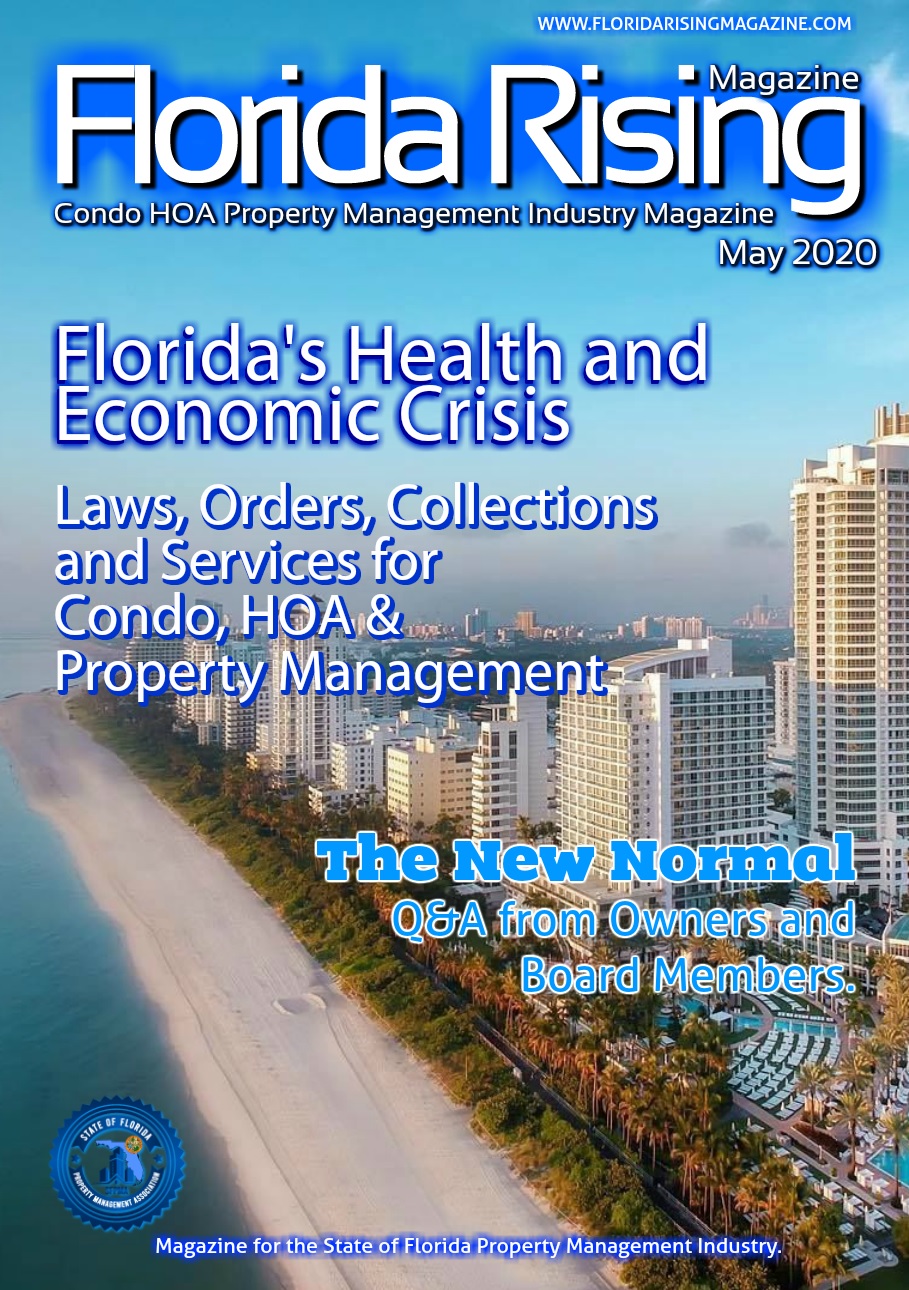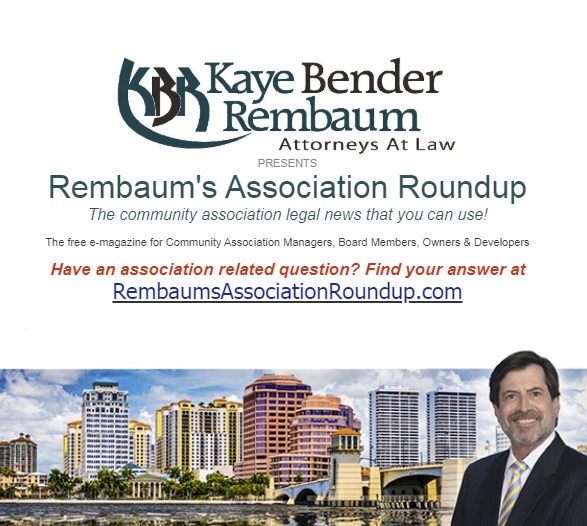Re-opening Amenities In Times Of Uncertainty pt. 1
by Kaye Bender Rembaum
The re-opening of amenities is anything but easy due to the local Orders being promulgated by Palm Beach, Broward and Miami-Dade Counties. Please be sure to review your County’s specific order(s) to ensure your association remains in compliance. These Orders have similarities but are also VERY different.
A link to the recent re-opening Orders follows:
–Palm Beach County, Emergency Order Number 5
–Broward County, Emergency Order 20-08
–Miami-Dade County, Emergency Order 21020
As to the Palm Beach County Order, take note that that staff and management are responsible to ensure compliance with the Order with respect to the tennis/racquet court facilities, and that one or more facility staff or management must be present at the pool to monitor and “ensure compliance with the restrictions of the Order.” However, it is not at all clear what measures must be taken to “ensure compliance with this Order.” We do not think it would be sufficient to only post a sign setting forth the CDC Guidelines and the additional restrictions in the Order. Although the tennis/racquet court facilities guidelines, unlike the community pool guidelines, do not require personnel to be present at the tennis/racquet courts to monitor and ensure compliance, in our opinion the board should consider some type of responsible monitoring.
Webinar: Association Continuity During COVID-19
Thursday, May 7, 2020
12 Noon to 1:00pm
 Kaye Bender Rembaum attorneys Michael S. Bender and Jeffrey A. Rembaum will be a part of a panel discussion presented by Castle Group, in Episode 2 of “Association Continuity and Other COVID-19 Concerns.” There will be a special focus on the re-opening of community amenities.
Kaye Bender Rembaum attorneys Michael S. Bender and Jeffrey A. Rembaum will be a part of a panel discussion presented by Castle Group, in Episode 2 of “Association Continuity and Other COVID-19 Concerns.” There will be a special focus on the re-opening of community amenities.
Panelists include:
Craig Vaughan, Castle Group President
Michael S. Bender, Esq., BCS
Jeffrey A. Rembaum, Esq., BCS
Brendan T. Lynch, AIP AAI, Plastridge Insurance, President
Register to Attend HERE
With respect to a swimming pool in Palm Beach County, “facility staff or management” must be present at the pool whenever it is open to monitor and ensure compliance with the restrictions set out in the Order, including social distancing and pool bathroom sanitation. If that cannot be accomplished, then the pool and or bathrooms should remain closed.
When opening a swimming pool in Broward County, their Order provides that the pool may not operate at more than 50% capacity. In person supervision in addition to sanitizing gates, railings and showers is required if the pool deck furnishings are left in place. However, by removing the furnishings, the wording of the Order seems to indicate the need to sanitize gates, railings and showers has been eliminated. If the decision by the Board is to reopen the pool, whether the furnishings remain or are removed a level of reasonable cleaning/sanitizing should be maintained, as necessary maintenance remains a continuing obligation of the association with regard to common elements/areas, which would require sanitizing the pool gates, handrails, doors, bathrooms and the like minimally as the association normally would, but clearly should be performed more frequently during these times.
Residents of Miami-Dade County will have to wait a while longer to be able to use their association swimming pool because their Order does not yet address opening association swimming pools.
We have heard that certain county staff are giving their personal interpretations of the Order(s) in response to questions from board members. If you think that relying on these unofficial and unauthorized interpretations will shield your association from immunity, think again! It is far more likely that staff interpretations of the County Orders will not provide any protection whatsoever, most especially if a resident contracts Covid-19 and a lawsuit is brought against the association. Until local governments revise their Orders to provide missing clarity, the plain language, conservative interpretation of these Orders should be followed to help ensure your association is protected as much as possible under the circumstances. Remember, too, that an association can have stricter requirements than those set out in the orders, but cannot adopt less strict requirements.
It is also unclear from the Orders how governmental enforcement of the restrictions is to occur by the County or any municipality, as it seems very (very) unlikely that there will be patrols driving around to check on compliance. Even if such patrols did exist, they could not hope to keep up. The more likely scenario is that the self-reporting of violations could possibly lead to monetary or other penalties against the association. Clearly, if the Board is of the opinion that the requirements in their County’s Order cannot be met at this time, it or are removed is certainly within the reasonable business judgment of the Board to keep those amenities closed. However, that said, reasonable business judgment should not be used by a board to make a decision to open amenities where the board believes it lacks the ability to be fully compliant with their county’s local Orders.
We encourage board members to contact their association’s legal counsel for guidance regarding reopening any tennis/racquet courts and/or pool facility, and to continue to monitor the guidelines, directives and orders issued by the CDC and the applicable local authorities. Stay safe.
 Kaye Bender Rembaum, Attorneys at Law
Kaye Bender Rembaum, Attorneys at Law
The law firm of Kaye Bender Rembaum, with its 19 lawyers and offices in Broward, Palm Beach and Hillsborough Counties, is a full service law firm devoted to the representation of more than 1,200 community and commercial associations, developers, and their members throughout the State of Florida. Under the direction of attorneys Robert L. Kaye, Michael S. Bender and Jeffrey A. Rembaum, the law firm of Kaye Bender Rembaum strives to provide its clients with an unparalleled level of personalized and professional service that takes into account their clients’ individual needs and financial concerns.
http://KBRLegal.com
Tags:
Condo and HOA Board of Directors,
Condo and HOA Laws,
Law and Legal,
Management News,
Members Articles
 All donations will go to Florida Food Force, Inc – a local food bank located in Odessa to help feed our local families in need amidst the pandemic.
All donations will go to Florida Food Force, Inc – a local food bank located in Odessa to help feed our local families in need amidst the pandemic.




 Need more resources? Think about taking out
Need more resources? Think about taking out 
 Lakes, ponds and wetlands are valuable resources for boating and recreation, fishing, drinking water, stormwater collection, aesthetic beauty and wildlife habitat. But they also serve as common breeding grounds for pesky insects like aquatic midge flies, often referred to as “midge bugs” or “blind mosquitoes.” Midge flies belong to a very large and diverse family of aquatic insects. While often thought of as the “cousin” of
Lakes, ponds and wetlands are valuable resources for boating and recreation, fishing, drinking water, stormwater collection, aesthetic beauty and wildlife habitat. But they also serve as common breeding grounds for pesky insects like aquatic midge flies, often referred to as “midge bugs” or “blind mosquitoes.” Midge flies belong to a very large and diverse family of aquatic insects. While often thought of as the “cousin” of  Managing midge fly populations below nuisance levels requires an integrated approach to achieve successful long-term control—starting with bathymetric mapping of the habitat and a professional larvae assessment. Midge larvae surveys are crucial tools to determine which midge species are present and how to effectively manage them.
Managing midge fly populations below nuisance levels requires an integrated approach to achieve successful long-term control—starting with bathymetric mapping of the habitat and a professional larvae assessment. Midge larvae surveys are crucial tools to determine which midge species are present and how to effectively manage them.












 Kaye Bender Rembaum attorneys Michael S. Bender and Jeffrey A. Rembaum will be a part of a panel discussion presented by Castle Group, in Episode 2 of “Association Continuity and Other COVID-19 Concerns.” There will be a special focus on the re-opening of community amenities.
Kaye Bender Rembaum attorneys Michael S. Bender and Jeffrey A. Rembaum will be a part of a panel discussion presented by Castle Group, in Episode 2 of “Association Continuity and Other COVID-19 Concerns.” There will be a special focus on the re-opening of community amenities. Kaye Bender Rembaum, Attorneys at Law
Kaye Bender Rembaum, Attorneys at Law


 With a pandemic crippling the global economy, community associations must prepare for the effects this will have on the housing market.
With a pandemic crippling the global economy, community associations must prepare for the effects this will have on the housing market.
